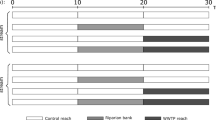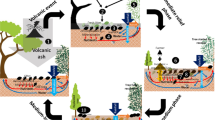Abstract
Desert pavements of white quartz stones (quartz fields) represent azonal habitats in several arid regions of southern Africa. The vegetation of these quartz fields is characterised by dwarf and highly succulent growth forms which contrast strongly with the shrubby vegetation of the surroundings. Incoming and reflected global solar radiation, air temperature near the ground, soil-surface temperatures and leaf-surface temperatures of dwarf plants were determined under natural habitat conditions inside and outside of the quartz fields. Surface temperatures of quartz and shale stones were compared. The study was conducted in the Knersvlakte and the Little Karoo (Succulent-Karoo Biome), South Africa. The daily maximum temperatures of the air near the ground of quartz fields was several degrees lower than the air near the ground of neighbouring soils without quartz cover. Maximum soil-surface temperatures of the quartz fields, however, were only lower in summer. Accordingly, the leave surfaces of dwarf plants (Aizoaceae) growing inside quartz fields were up to 3 K cooler than identical plants outside the quartz fields. The lower maximum temperatures is associated with an about 5% higher reflection of quartz fields compared to neighbouring soils without quartz cover. At night, the minimum temperatures of the air near the ground and the soil surface temperatures on quartz fields were above those of soils without quartz cover. The nocturnal surface temperatures of quartz stones did not differ considerably from that of shale and often ranged above the temperatures and dew-point of the ambient air. Consequently, the relatively cooler quartz fields seem to provide less adverse growing conditions for plants near the ground compared to surrounding soils without quartz cover.
Similar content being viewed by others
References
Bittrich V. and Hartmann H.E.K. 1988. The Aizoaceae – a new approach. Botanical Journey ofthe Linnean Society 97: 239–254.
Büdel B. and Wessels D.C.J. 1991. Rock inhabiting blue-green algae/ cyanobacteria from hot arid regions. Algological Studies 94: 385–398.
Cowling R.M., Esler K.J. and Rundel P.W. 1999. Namaqualand, South Africa – an overview of a unique winter-rainfall desert ecosystem. Plant Ecology 142: 3–21.
Desmet P.G. and Cowling R.M. 1999. The climate ofthe karoo – a functional approach. In: Dean W.R.J. and Milton S.J. (eds), The Karoo: ecological patterns and processes. Cambridge University Press, Cambridge, pp. 3–16.
Eller B.M. 1982.Strahlungsabsorption von Argyroderma pearsonii (N.E.Br.) Schwantes in der Vegetations-und Ruheperiode. Berichte der Deutschen Botanischen Gesellschaft 95: 333–340.
Eller B.M. and Grobbelaar N. 1986. Diurnal temperature variation in and around a Lithops lesliei plant growing in its natural habitat on a clear day. South African Journal of Botany 52: 403–407.
Eller B.M. and Ruess B. 1982. Water relations of Lithops plants embedded into the soil and exposed to free air. Physiologia Plantarum 55: 329–334.
Eller B.M. and Nipkow A. 1983. Diurnal course of the temperature in a Lithops sp. (Mesembryanthemaceae Fenzl) and its surrounding soil. Plant, Cell and Environment 6: 559–565.
Hammer S.A. 1993. The genus Conophytum. A conograph. Succulent Plant Publications, Pretoria.
Hammer S.A. 2002. Dumpling and His Wife. New Views of Conophytum N.E. Br. East Anglia Engraving, London.
Hartmann H.E.K. 1981. Ecology, distribution and taxonomy in Mesembryanthemaceae as a basis for conservation decisions. In: Synge H. (ed.), The Biological Aspects of Rare Plant Conservation. John Wiley & Sons Ltd, pp. 297–303.
Hoffman M.T. and Cowling R.M. 1987. Plant physiognomy, phenology and demography. In: Cowling R.M. and Roux P.W. (eds), The Karoo Biome: a preliminary synthesis. Part 2: Vegetation and history. CSIR, Pretoria, pp. 1–34.
Jürgens N. 1986. Untersuchungen zur Ökologie sukkulenter Pflanzen des südlichen Afrika. Mitteilungen aus dem Institut für Allgemeine Botanik Hamburg 21: 139–365.
Jürgens N. 1991. A new approach to the Namib Region. I: Phytogeographic subdivision. Vegetatio 97: 21–38.
Milton S.J., Yeaton R.I., Dean W.R.J. and Vlok J.H.J. 1997. Succulent karoo. In: Cowling R.M., Richardson D.M. and Pierce S.M. (eds), Vegetation of Southern Africa. Cambridge University Press, Cambridge, pp. 131–166.
Nobel P.S. 1984. Extreme temperatures and thermal tolerances for seedlings ofdesert succulents. Oecologia 62: 310–317.
Nobel P.S. 1989. Shoot temperatures and thermal tolerances for succulent species of Haworthia and Lithops. Plant, Cell and Environment 12: 643–651.
Nobel P.S., Geller G.N., Kee S.C. and Zimmerman A.D. 1986. Temperatures and thermal tolerances for cacti exposed to high temperatures near soil surface. Plant, Cell and Environment 9: 279–287.
Palmer A.R. and Hoffman M.T. 1997. Nama Karoo. In: Cowling R.M., Richardson D.M. and Pierce S.M. (eds), Vegetation of Southern Africa. Cambridge University Press, Cambridge, pp. 167–188.
Rumrich U., Rumrich M. and Lange-Bertalot H. 1989. Diatomeen als “Fensteralgen” in der Namib-Wüste und anderen ariden Gebieten von SWA/Namibia. Dinteria 20: 23–30.
Rumrich U., Rumrich M. and Lange-Bertalot H. 1992. Diatomeen unter Steinen in der Namib-Wüste und angrenzenden Savannen. Acta Biologica Benrodis 4: 53–66.
Schmiedel U. 2002. The quartz fields of southern Africa. Flora, phytogeography, vegetation, and habitat ecology. PhD Dissertation, University of Cologne.
Schmiedel U. and Jürgens N. 1999. Community structure on unusual habitat island: quartz-fields in the Succulent Karoo, South Africa. Plant Ecology 142: 57–69.
Schmiedel U. and Jürgens N. 2002. Untersuchungen zur Steuerung der Lebensformzu–sammensetzung der Quarzflächen-Vegetation im ariden südlichen Afrika. Beitrage der Tüxengesellschaft 714: 45–58.
Turner J.S. and Picker M.D. 1993. Thermal ecology ofan embedded dwarf succulent from southern Africa (Lithops ssp: Mesembryanthemaceae). Journal ofArid Environments 24: 361–385.
Vogel S. 1955. Niedere “Fensterpflanzen” in der südafrikanischen Wüste. Eine ökologische Sondierung. Beiträge zur Biologie der Pflanzen 31: 45–135.
von Willert D.J., Eller B.M., Werger M.J.A., Brinckmann E. and Ihlenfeldt H.-D. 1992. Life strategies of succulents in deserts with special reference to the Namib desert. Cambridge University Press, Cambridge, New York, USA.
von Willert D.J., Matyssek R. and Herppich W. 1995. Experimentelle Pflanzenökologie. Georg Thieme, Stuttgart.
Weather Bureau 1988. Climate of South Africa. Climate statistics up to 1984. Department of Environment Affairs, Pretoria.
Author information
Authors and Affiliations
Corresponding author
Rights and permissions
About this article
Cite this article
Schmiedel, U., Jürgens, N. Habitat ecology of southern African quartz fields: studies on the thermal properties near the ground. Plant Ecology 170, 153–166 (2004). https://doi.org/10.1023/B:VEGE.0000021661.56381.67
Issue Date:
DOI: https://doi.org/10.1023/B:VEGE.0000021661.56381.67




